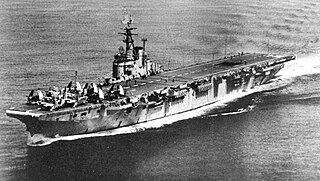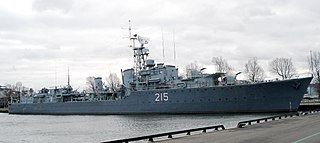Related Research Articles

The Royal Canadian Navy is the naval force of Canada. The RCN is one of three environmental commands within the Canadian Armed Forces. As of 2021, the RCN operates 12 frigates, four attack submarines, 12 coastal defence vessels, eight patrol class training vessels, two offshore patrol vessels, and several auxiliary vessels. The RCN consists of 8,570 Regular Force and 4,111 Primary Reserve sailors, supported by 3,800 civilians. Vice-Admiral Angus Topshee is the current commander of the Royal Canadian Navy and chief of the Naval Staff.
The history of the Royal Canadian Navy goes back to 1910, when the naval force was created as the Naval Service of Canada and renamed a year later by King George V. The Royal Canadian Navy (RCN) is one of the three environmental commands of the Canadian Forces. Over the course of its history, the RCN has played a role in the First World War, contributed significantly to the Battle of the Atlantic during the Second World War, and was a part of NATO's force buildup during the Cold War. In 1968, the RCN was amalgamated with the Canadian Army and the Royal Canadian Air Force to form what is today the unified Canadian Armed Forces. The naval force was known as Maritime Command until 2011, when the environmental command was renamed as the Royal Canadian Navy.

HMCS Magnificent was a Majestic-class light aircraft carrier that served the Royal Canadian Navy from 1948–1957. Initially ordered by the Royal Navy during World War II, the Royal Canadian Navy acquired the Magnificent while waiting for another aircraft carrier to be completed to their needs and it entered service in 1948 replacing in service HMCS Warrior which had been loaned for two years by the RN.

HMCS Haida is a Tribal-class destroyer that served in the Royal Canadian Navy (RCN) from 1943 to 1963, participating in World War II and the Korean War. She was named for the Haida people.
Several Canadian naval units have been named HMCS Vancouver. One was named for the explorer George Vancouver, the others after the city of Vancouver.
Rear Admiral Robert Walter Timbrell, CMM, DSC, CD, Royal Canadian Navy was the first Canadian to be decorated with the Distinguished Service Cross during the Second World War. This followed his part in Operation Dynamo where he was personally responsible for the evacuation of 900 troops from the beaches of Dunkirk.

HMCS Micmac was a Tribal-class destroyer which served the Royal Canadian Navy from 1945 to 1964. Micmac was the first modern, high-performance warship built in Canada. She was the first of four Tribal destroyers built at the Halifax Shipyard and one of eight Tribal-class destroyers to serve in the Royal Canadian Navy.
Several Canadian naval units have been named HMCS Chaudiere.
Two Canadian naval units have been named HMCS Fraser.

HMCS Crescent was a C-class destroyer that was built for the Royal Navy but was transferred before completion and saw active service with the Royal Canadian Navy. She was one of 32 destroyers of that class built between 1943 and 1945 as part of the War Emergency Programme.

Vice Admiral Henry George DeWolf was a Canadian naval officer who was famous as the first commander of HMCS Haida during the Second World War.

Vice-Admiral Edmond Rollo Mainguy, was a senior officer in the Royal Canadian Navy.
Several Canadian naval units have been named HMCS Kootenay.
HMCS Qu'Appelle can refer to several different things named after the Qu'Appelle River in Saskatchewan:
Several Canadian naval units have been named HMCS Restigouche.
Several Canadian naval units have been named HMCS St. Laurent.

The River class was a class of fourteen destroyers of the Royal Canadian Navy (RCN) that served before and during the Second World War. They were named after Canadian rivers.
Three ships of the Royal Navy have borne the name HMS Crusader, after the participants in the Medieval Crusades:
Rear-Admiral William Moss Landymore, OBE, CD was a Canadian naval officer. Born in Brantford, Ontario, Landymore joined the Royal Canadian Navy in 1936, but spent much of early career training with the Royal Navy. During World War II, Landymore returned to the Royal Canadian Navy and served aboard destroyers in the Battle of the Atlantic, surviving two sinkings. By the end of the war Landymore had taken a series of positions in Ottawa before returning to destroyer command during the Korean War. He was promoted through the ranks eventually becoming the first Commander of Maritime Command. :andymore became embroiled in a public feud with the Minister of National Defence following the Unification of the Canadian Armed Forces and resigned as a result. He died at Halifax, Nova Scotia.
Several Canadian naval units have been named HMCS Columbia.
References
- ↑ "South-West Asia Theatre Honours". Prime Minister of Canada. Archived from the original on May 12, 2014. Retrieved 9 May 2014.
- Directorate of History and Heritage - HMCS Ottawa Archived 2012-03-04 at the Wayback Machine